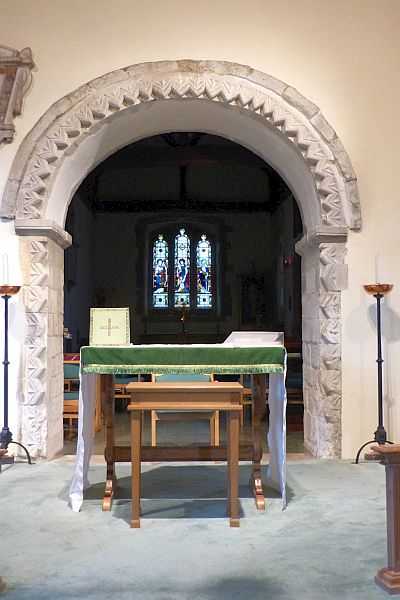
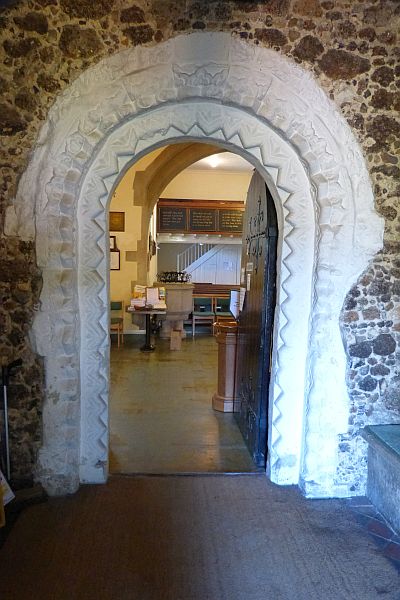
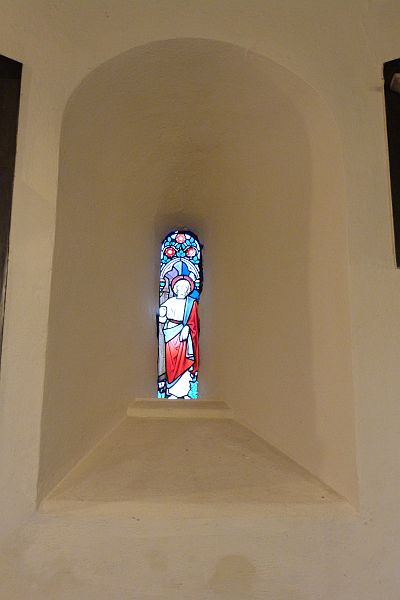
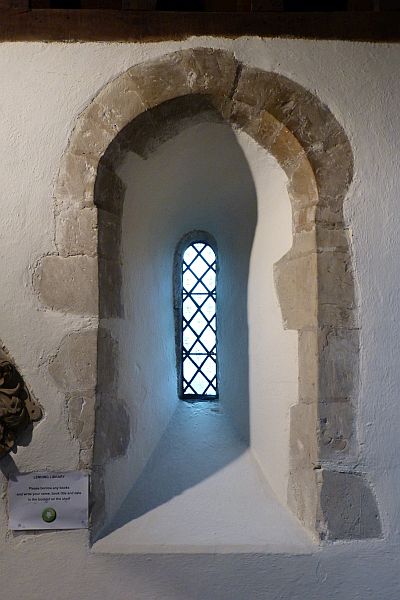
St. Mary's church in Bedfont is a Grade II listed building. According to the listing information from 1953, it is:
Norman, with original chancel, retaining chancel arch and 1 window, and part of original nave retaining good South doorway. Wall paintings of circa 1300 to North of chancel arch. Mediaeval King-post roofs to nave and chancel. Pleasant series of tablets of C18 and early C19 date, and brass to William Page and Isabell his mother 1629-32. Gravestones and table tombs of C18 and later date in churchyard and pair of yew trees, formerly clipped and originally bearing initials and the date of 1704. The church was enlarged in the early C19 on the North side and again circa 1865 when the nave was lengthened and a new tower and South porch were built.
The date of the foundation of the church is unknown. East Bedfont is listed in the 1086 Domesday Survey (named as Bedefunde). There were 14 households, and the tax value was an impressive 12 geld units. There is no mention of the church, but as it would not have been taxable, this proves nothing. Assuming that there was a church, it would probably have been of wooden construction.
The most likely date for the (re-)building of the church in stone is mid-12th century, either during the reign of Henry I (died 1 December 1135) or that of Henry II (crowned 19 December 1154). Few if any churches were built during the reign of King Stephen, a 19 year period often known as ‘the Anarchy’. However, the 12th century date was not agreed with by Lt-Col. Bertram Shore, who became St. Mary’s inspecting Architect in 1955:
This second examination of the fabric of the Church has strengthened the opinion I had before that much of the masonry belongs to the Saxon period when the details which we describe as Norman were fashionable through Western Europe. I think that the more ancient masonry which we see in the Choir and Nave dates from the time when Edward the Confessor was building Westminster Abbey and Harold of England was building Waltham Abbey. There are features which make the workmanship unlike the masonry being carried out after the conquest.
The original features that still exist are the Chancel arch, south doorway, and small windows in the nave and chancel.




During the 14th and 15th centuries, the church was under the authority of the Trinitarian Priory in Hounslow,
which presented its vicars from 1325.
That date is slightly later than the ascribed dates of the wall paintings (see photograph),
which depict Christ on the Cross (right) and Christ reigning in Glory (left).
The church guide written by Francis Clive-Ross gives their date as 1240-1250, and notes that they were uncovered in September 1865.
Their quality and detail, obvious even today, suggests that they were painted by professional artists.
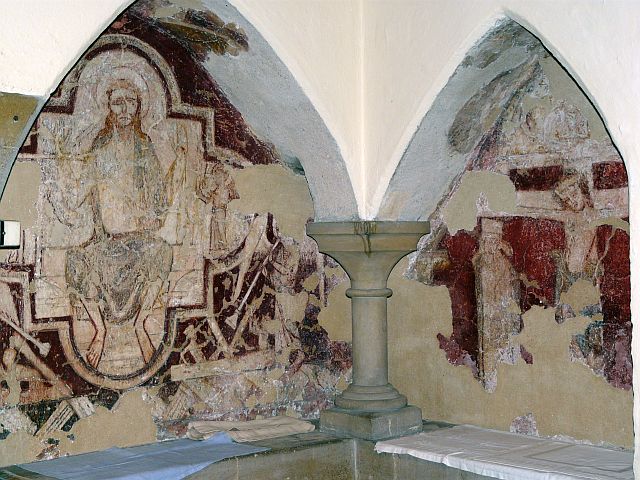
The main change to the church during the 15th century was the extension to the chancel. At less than 10 feet (3 metres), this was not a major remodelling.
Many ‘Norman’ churches was rebuilt in the then-fashionable Perpendicular architectural style during the later Middle Ages. This required a wealthy patron, many of whom had made their fortunes in the wool trade. Bedfont does not appear to have had such a person, nor did anything of historical significance happen here. Thus we are left with the precious architectural relic that is the core of our church.
The Hounslow Priory was dissolved by Henry VIII in about 1539. After that time the parish would have had an independent existance, albeit as part of the Diocese of London. Often after the break from Rome the adsvowson or patronage of the parish was sold by the Crown to a wealthy individual. This did not happen at Bedfont, and so we are a ‘Royal Patronage’, with the appointment of Vicars being administered by the Lord Chancellor's Ecclesiastical Office.
In common with most other churches in England and Wales, during the reigns of Edward VI or Elizabeth I the wall paintings would have painted over, the rood screen dismantled, and interior statues removed or destroyed. The most obvious evidence of changes to the church's structure during this time is the brickwork that can be seen outside the south side of the nave, east of the South Door.
In the 18th century, Bedfont was rather a backwater, although not isolated,
as the main road from London to Exeter passed next to the Green, where at one time there were 3 coaching inns.
The churchyard contains a number of impressive monuments from this time, and 8 of them are listed structures.
Also in the churchyard are our famous ‘Peacocks’, which were cut into the shape of peacocks, or perhaps fighting cocks,
probably in 1704 (the date that was shown trimmed into them in illustrations dating from the 18th and 19th centuries).
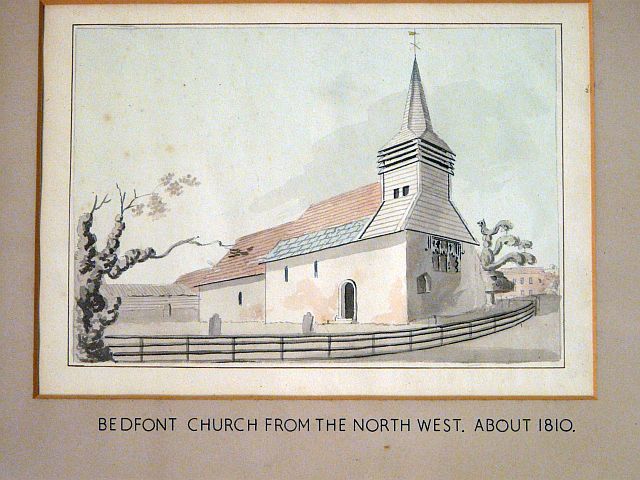
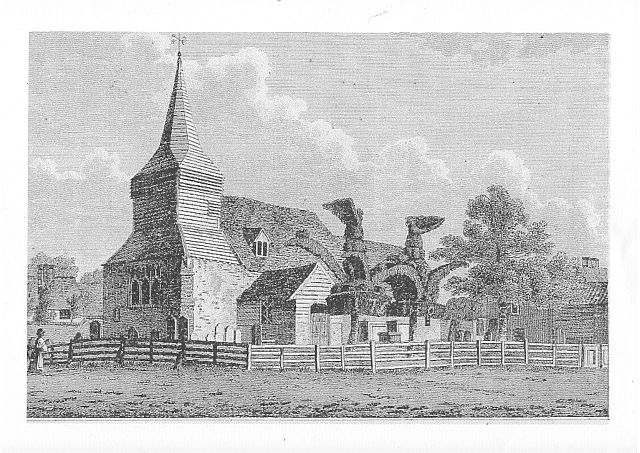
There is a plaque in the porch relating to what is variously called the Annexe or North Transept:
This Church was Enlarged and New-Pewed, in the Year 1829, by which means 244 additional Sittings were obtained, and, in Consequence of a Grant from the Incorporated Society for promoting the Enlargement, Building and Repairing of Churches and Chapels, 197 of that number are hereby Declared to be Free and unappropriated for ever, in addition to 42 formerly provided.
The Revd. Robert Jones D.D. Vicar.
William Reed Esqr. Churchwardens.
Mr. George Daws
Bertram Shore (who surveyed the church in 1955) was not keen on it!
The whole of the North wall of the Nave was pulled down in 1829 and the particularly abominable Victorian pier and arches in Monks Park Bath stone were constructed for an opening into the out-sized transept which was built of London Stock bricks with a very flat-pitched roof covered with Welsh slates. The hideously depressing effect of these Victorian essays in Bath stone is not just the result of changing fashions but is basic: I stood and sat behind them when I was still too small to have any learning beyond the experience of various flavours and smells and I knew that the authors had done evil in the sight of the Lord. It is all very sound except that the front of the gallery in this Transept is not really safe and should be stiffened. The pews and stairs are sound and I could find no fault in them. Mr Smith [then Churchwarden] suggested that the pier might be improved by painting white. I am, generally, horrified at the suggestion of painting stones, which I love, but I agree with Mr Smith: the coarse roundness of the pier and cap would be more easily lost sight of if white against a white wall and there is little enough beauty left in Monks Park stone when it has been sawn and rubbed.
The pier and cap were not painted, but the balcony is now structurally sound, although not required on most Sundays.
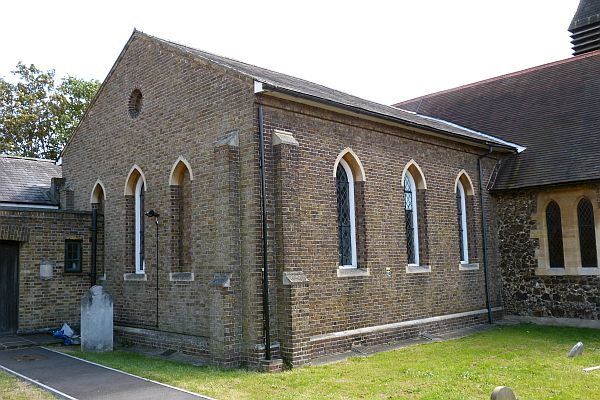
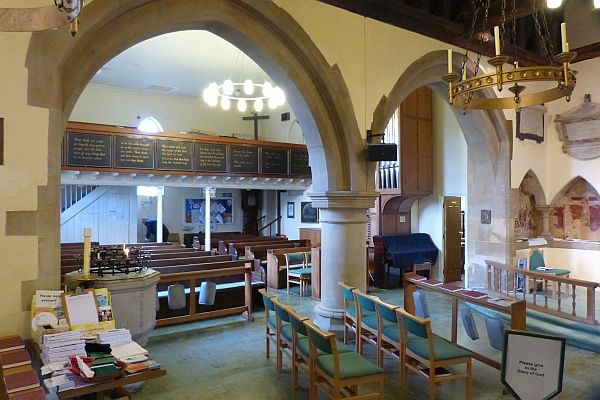
According to the church guide, while the Rev'd Henry Vincent Le Bas was vicar (from 1859 to 1871) plans were drawn up to rebuild the whole church in Victorian Gothic style. Who drew up these plans and why they were not proceeded with is not discussed, but we can be grateful that it did not happen.
The rebuilding project that did happen was, however, major.
The wooden bell turret and spire were removed and the nave lengthened and re-roofed.
A new bell-tower and replacement porch were built.
A new chancel doorway was built.
The 1865 stone-work is conglomerate with Bath Stone quoins and dressings,
and as such is sympathetic to the remaining medieval stonework.
This left the church looking much as it does now, at least from the south, as shown below.
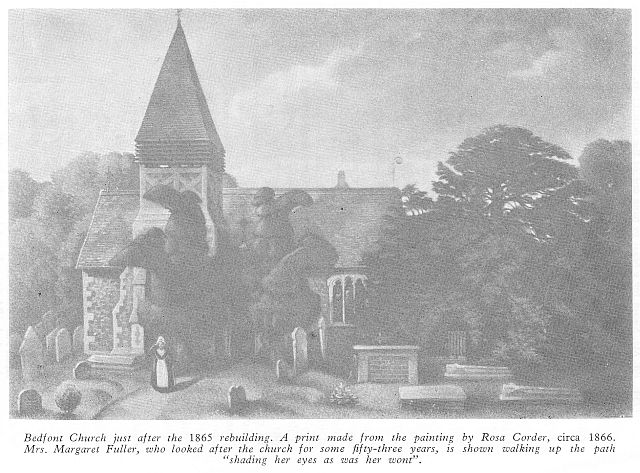
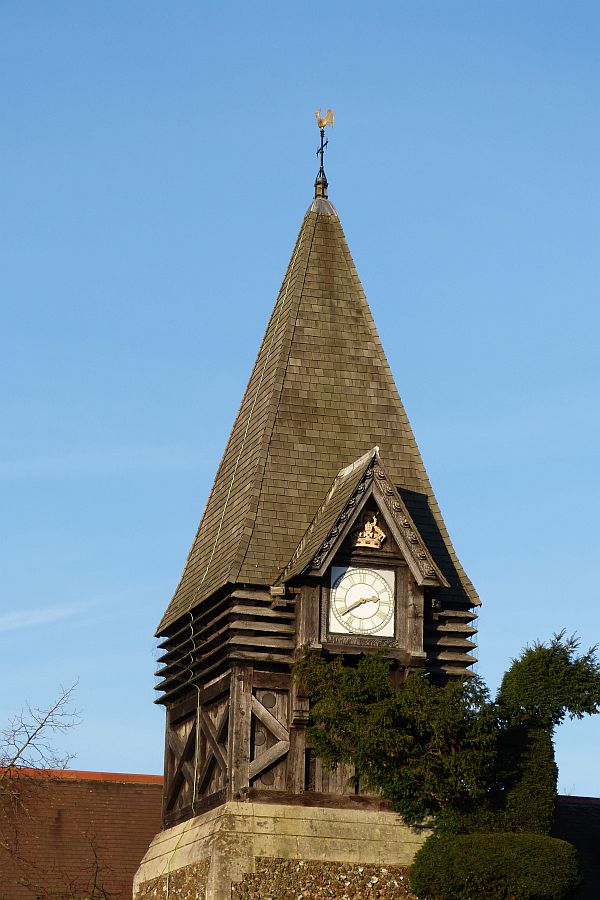
The tower clock was added either in 1897 to mark Queen Victoria's Diamond Jubilee, or in 1902 to mark King Edward VII's coronation. The clock was originally hand-wound, twice per week, until an electric mechanism was installed in about 1977. That mechanism is responsible for the change in striking interval after the 5th hourly bell strike.
From another plaque in the Porch:
To the Glory of God the Tower of this Church was restored, the Bells overhauled and rehung in the year of our Lord 1934 at a total cost of £450 raised by Parishioners during 1 year & 6 months.
Vicar, The Rev. G. J. M. Kingston, B.A.
Churchwardens Capt. Leslie E. Elwell.
S. G. Peacock, Esq.
That amount has the equivalent purchasing power of about £30,000 today.
The vestry block to the north-east of the church was built in 1954. Before then the choir and servers had to robe behind curtains hung from the bottom of the balcony in the Transept.
Our organ was dedicated to the Glory of God
in 1960.
The cost was met by special efforts, donations and gifts in memory of the departed.
Death-watch beetle was discovered in 1964. As a result of their depradations, the church had to be partly re-roofed, and many of the pews were scrapped, to be replaced by chairs in the nave. Also, the church was re-floored, with under-floor heating put in. Recently this has mostly failed, and a permanent replacement solution is being sought.
In 1990 funds were raised from local businesses and individuals to pay for an expert topiarist to recut the yew trees flanking the South Porch, which had completely lost their 'peacock' shape since the Second World War. The new design does not resemble the previous one to any great extent, but is readily recognisable as peacocks. It incorporates the original 1704 date on the left-hand tree, and replaced the intials on the right-hand tree with ‘1990’.
The church's floodlighting was established in 1999, being paid for by a grant from the Millennium Floodlighting Trust
allied to several generous donations from local residents and businesses.

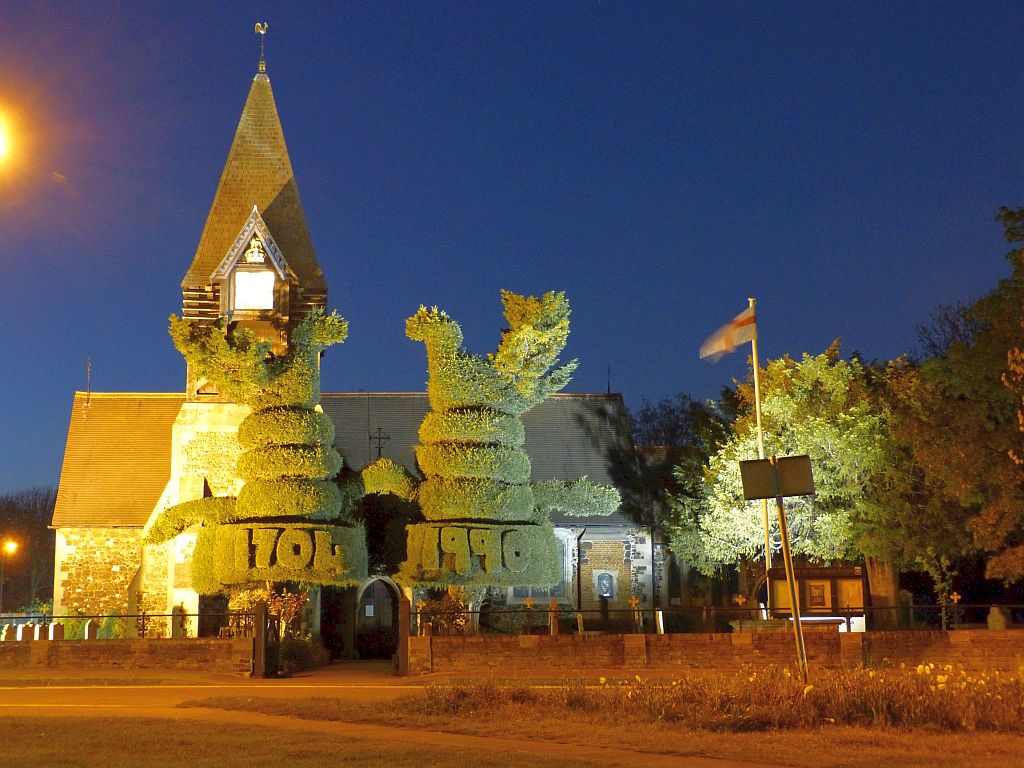
For an illustrated description of the church's stained glass, click here.
For an illustrated description of the church's monuments, click here (external site).
Copyright 2016, 2017 The Parochial Church Council of the Ecclesiastical Parish of Saint Mary the Virgin, Bedfont.